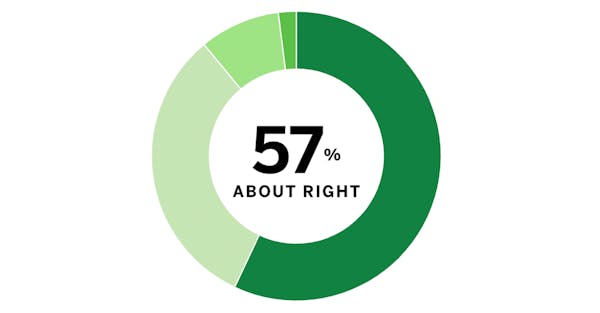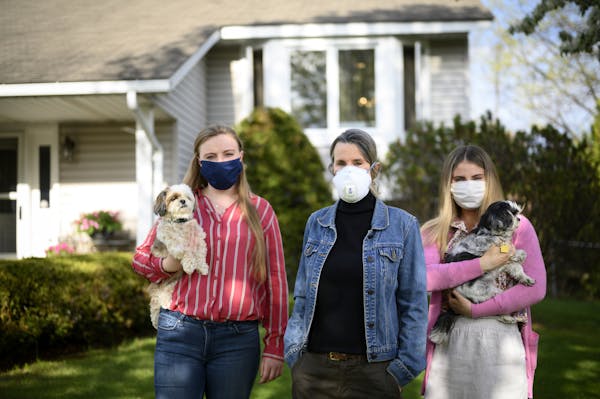More than two-thirds of Minnesotans say they won't return to normal rhythms of daily life even though some social distancing restrictions have been relaxed, and many believe the worst of the coronavirus pandemic is yet to come, according to a new Star Tribune/MPR News/KARE 11 poll.
As anxiety about the virus persists, the poll also found a majority of people support the stay-at-home restrictions and business closures they lived under for nearly two months and say they were necessary to limit the spread of the virus in their communities.
In the poll of 800 registered voters — conducted May 18 through May 20 — 57% of respondents said the restrictions are the right approach to prevent the coronavirus from spreading, while 32% said they have gone too far. Only 9% said the restrictions did not go far enough. Despite partisan divisions, a majority of independents also support the restrictions.
"The rest of them can do whatever they want, but I try and protect myself," said Gary Lenius, who lives in Two Harbors and supports the restrictions because he's 78 and at a higher risk of severe illness if he catches the virus. Plus, he said, staying at home fits his lifestyle. "I'm not going to go out and run around, I'm going to play it cautious and wait and see and take my time. That rocking chair fits quite well by this time."
The Mason-Dixon poll, which has a 3.5% margin of error, comes as DFL Gov. Tim Walz begins to slowly turn the dial on a stay-at-home order that, for 51 days, shuttered noncritical businesses and asked Minnesotans to stay inside except for essential needs and services. That order was lifted on Monday and replaced with a new measure that allows Main Street businesses and retailers to open their doors, while still limiting group gatherings to no more than 10 people.
Under a separate order, bars and restaurants in the state have been closed for dine-in services since March 17, as have movie theaters, gyms, hair salons, concert venues and other public spaces that put people in close contact. Starting June 1, Walz said restaurants and bars can start serving up to 50 patrons outdoors and hair salons and barbershops can reopen at 25% capacity, as long as employees and customers wear masks.
Support for Walz's restrictions is higher among women, people living in Hennepin and Ramsey counties and those who identify as Democrats. But strong support for the restrictions was found statewide, not only in urban areas. A majority of independents also back the restrictions, with 60% saying they're about right or don't go far enough, compared with 37% who said they've gone too far.
Statewide, 65% of Republicans say the restrictions have gone too far. Walz's orders also have come under sharp attack from conservative groups and GOP lawmakers in the Minnesota Legislature, who argue they've been applied unevenly and will lead to a devastating economic downturn. Since March, about 700,000 Minnesotans have filed for unemployment benefits.
Mark Peterson, who has owned an auto repair businesses for more than 30 years, said he's taken a hit as people have been driving less and staying close to home during the crisis. He said Walz's restrictions have gone "way too far."
"I just find it difficult to think that the government can tell a small business not to be open, and that's their livelihood," said Peterson. "If somebody told me I couldn't open my door or couldn't do what I put my whole life into, I'd really be upset about it and fight it."
He was one of the 36% of Minnesotans who say they have had someone in their household lose a job or income due to the pandemic. The economic toll appeared to be spread fairly evenly across the state, with just about 50% of people in all regions saying no one in their home had lost income. The rest did not have any workers in the house.
Peterson, who splits his time between Cohasset and Owatonna, said store closures are what keep him from going out right now, not health concerns. However, given the recent COVID-19 outbreak at the Viracon glass factory in Owatonna, he said he would be more cautious in that area. But when he is in rural Cohasset, near Grand Rapids, he hasn't felt a need to change his lifestyle much.
"I'm from a smaller community where I don't feel like I have to worry quite as bad. Maybe if I was in the middle of a big city, I would have a different thought," Peterson said. He also said he might be more cautious if he were frequently around the elderly or people with health complications.
Peterson is part of 29% of respondents who said they will resume their normal activities as restrictions are lifted. But a third of those polled said they will continue to limit how much they go out. Another 27% said their movements will be "very limited" and 11% said they will continue to shelter inside until there's a vaccine or the risk of the virus fades.
A plurality of people polled — 42% — believe the worst of the pandemic is yet to come, as the number of lab-confirmed cases continues to rise and Minnesota has seen new highs for the total number of deaths in one day. Thirty percent of respondents said the virus is not a problem in their community, while 16% said the state is experiencing the worst of the pandemic now.
COVID-19 has popped up in almost all Minnesota counties, but according to Minnesota Department of Health data, some counties have a higher concentration of cases. State officials have warned they expect the state to hit a peak in cases sometime in July, with a possible second wave later this year.
"I get concerned when I hear all of these scientists talk about how bad the fall and winter will be," said Elaina Buzzell, who lives in Minneapolis. "I would love for this to be over, I would love to get a cure and we can be done with this. I don't know anybody who doesn't want that and I hope it works out," she said. "Knowing how much a regular seasonal flu can wreak havoc on people, having that and [coronavirus] at the same time is something I'm personally pretty nervous about."
However, only 10% of respondents said they are very worried about getting seriously ill with COVID-19, with more than half saying they are not too worried or not worried at all. Among those living in greater Minnesota, just 5% or fewer are very worried about getting seriously sick.
A little more than a third of those surveyed said they know someone who has tested positive for the virus, with people living in Hennepin and Ramsey counties slightly more likely to know someone who has been infected.
As with support for Walz's restrictions, women were more likely to be concerned about getting sick. And fears about the illness appear starkly split along partisan lines.
While 22% of Democrats said they are very worried about getting a serious case of COVID-19, less than 1% of Republicans expressed that same level of worry. Among Republicans, 82% said they were not too worried about getting seriously sick or not worried at all.
While health experts say the elderly are most vulnerable to COVID-19, statewide nearly two-thirds of poll respondents ages 18 to 34 supported stay-at-home restrictions.
Sergio Salgado, a 26-year-old from Mankato who works at a private college, said he's not worried about getting sick from the virus. But even with relaxed rules, he said he plans to stay in to protect those around him who are more vulnerable.
"I'm a young millennial. I'm not susceptible to it," he said. "But it would be incredibly selfish for me to at least not protect those around me who could be autoimmune compromised and could be susceptible to the disease."

Want to share info with the Star Tribune? How to do it securely

'Safe recovery sites' would offer syringes, naloxone and more to people using drugs. The plan could be in peril.
New Minnesota GOP leaders seek peace with party's anti-establishment wing

Who is Republican Lisa Demuth, Minnesota's first House speaker of color?


